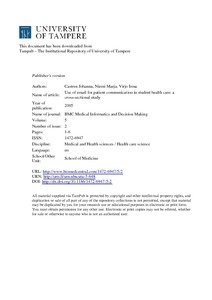Use of email for patient communication in student health care: a cross-sectional study
Castrén, Johanna; Niemi, Marja; Virjo, Irma (2005)
Castrén, Johanna
Niemi, Marja
Virjo, Irma
2005
BMC Medical Informatics and Decision Making 5
2
This publication is copyrighted. You may download, display and print it for Your own personal use. Commercial use is prohibited.
Julkaisun pysyvä osoite on
https://urn.fi/urn:nbn:uta-3-648
https://urn.fi/urn:nbn:uta-3-648
Kuvaus
BioMed Central Open access
Tiivistelmä
Background
Citizens increasingly use email in personal communication. It is not however clear to what extent physicians utilize it for patient communication. Our study was designed to examine physicians' activity in using email and to estimate the proportion of email messages missing from documentation in electronic patient records (EPR).
Methods
All physicians (n = 76; 48 general practitioners and 28 specialists) at the Finnish Student Health Service received a questionnaire by email, and were asked to print it and keep a daily tally of visits, phone calls and email messages over the study period of one working week (5.5. – 9.5.2003). The response rate was 70%. The data originating from the questionnaire were compared with statistical data from the EPR during the study period.
Results
The majority (79%, 41/52) of doctors reported using email with patients, averaging 8.6 (range: 0–96) email contacts and a percentage rate of "email / visit" 20% (range: 0–185%) in one working week. Doctors in the capital city region and those doctors who had a positive attitude toward email for patient communication were most active in email use. Up to 73% of email contacts were not documented in the EPR.
Conclusion
The activity in using email with patients verified among Finnish physicians is compatible with recent study results elsewhere. The notable proportion of un-recorded email messages establishes the need for an electric communication system built into the EPR to improve the quality of patient care and to limit medico-legal risks.
Citizens increasingly use email in personal communication. It is not however clear to what extent physicians utilize it for patient communication. Our study was designed to examine physicians' activity in using email and to estimate the proportion of email messages missing from documentation in electronic patient records (EPR).
Methods
All physicians (n = 76; 48 general practitioners and 28 specialists) at the Finnish Student Health Service received a questionnaire by email, and were asked to print it and keep a daily tally of visits, phone calls and email messages over the study period of one working week (5.5. – 9.5.2003). The response rate was 70%. The data originating from the questionnaire were compared with statistical data from the EPR during the study period.
Results
The majority (79%, 41/52) of doctors reported using email with patients, averaging 8.6 (range: 0–96) email contacts and a percentage rate of "email / visit" 20% (range: 0–185%) in one working week. Doctors in the capital city region and those doctors who had a positive attitude toward email for patient communication were most active in email use. Up to 73% of email contacts were not documented in the EPR.
Conclusion
The activity in using email with patients verified among Finnish physicians is compatible with recent study results elsewhere. The notable proportion of un-recorded email messages establishes the need for an electric communication system built into the EPR to improve the quality of patient care and to limit medico-legal risks.
Kokoelmat
- Artikkelit [6140]
